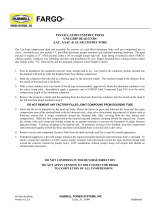Page is loading ...

FARGO
INS 886 (03/13/12) HUBBELL POWER SYSTEMS, INC. Page 1 of 2
Printed in U.S.A. Leeds, AL 35094 1908860000
INSTALLATON INSTRUCTIONS
CONVENTIONALCOMPRESSION DEADENDS
FOR ACSR CONDUCTORS
Deadend assemblies include aluminum body and steel deadend. Assemblies may also include jumper
terminals with mounting hardware. The standard aluminum dead end terminal pad is angled at 15,
as is the pad on the jumper terminal. This allows jumper take off at either 60 or 90 from span
conductor. Steel and aluminum components are stamped with die size, manufacturing date code and
FARGO catalog number. Aluminum deadend body is also marked with conductor size and type.
Jumper terminal is marked with conductor type and diameter range.
1. Prior to installation the conductor must be clean, straight and in lay. Any bend in conductor end
section will tend to make the deadend body bow during compression.
2. Conductor tension grip must be of a size and type approved by the conductor manufacturer.
3. Remove the protective plastic and end caps. Be sure the bores of the fittings are clear of foreign
matter. Do not remove any of the grit coating inside the steel barrel. Insert the conductor into the
tapered end of the aluminum deadend body and slide the body over the conductor, allowing
working room to install steel deadend on conductor core.
4. Cut-mark the aluminum strands at a distance, from conductor end, equal to the depth of the bore
in the steel deadend barrel plus 1 inch to allow for elongation of the barrel during compression.
Tape wrap the aluminum strands on the span side of the cut mark. Expose the steel core by
removing the aluminum strands to the cut mark. Do not nick the steel strands while cutting
away the aluminum strands.
5. Mount the SH die set specified on steel deadend barrel in press. Lubricate die faces and steel
compression barrel with light-weight oil. Fully insert conductor core into the steel barrel, and make
the first compression on the smooth portion of the steel barrel, adjacent the ribbed section.
Continue compression to the end of the steel barrel. Overlap each crimp by an amount necessary
to prevent the formation of ridges between adjacent crimps, and ensure complete die closure with
each crimp. To minimize bowing of the steel barrel, keep barrel well lubricated and fully seated in
one die half as dies close.
6. Mark the conductor at a distance from the aluminum strand cut end equal to the distance of the
conductor crimp zone on the aluminum deadend body (distance from 3rd knurl mark to open end),
plus 2 inches.
7. Mount the AH die set specified on the aluminum splice body in the press.
8. With a clean stainless steel wire brush (V-brush type recommended), aggressively brush the full
conductor circumference from cut-end tape wrap to the mark applied in step 6. Immediately apply
a generous coat of FARGO Joint Compound (UJC or HTJC) over the just-brushed conductor
surface. Remove tape wrap. Brush clean and coat with joint compound this remaining conductor
area.
9. Slide the aluminum deadend body over the steel deadend until snugly against the felt washer and
forging eye collar. Remove and set aside the deadend body filler port plug.
CONTINUED ON REVERSE

INS 886 (03/31/12) HUBBELL POWER SYSTEMS, INC. Page 2 of 2
Printed in U.S.A. Leeds, AL 35094 1908860000
10. With a caulking gun, inject FARGO UJC or HTJC, through the filler hole, until compound begins to
flow out between the aluminum body and the felt washer. (See table below for approximate
amount of compound required per deadend body). Hammer the aluminum plug / pin into the filler
hole. Cut, or file, off any excess length of pin and peen end flush with aluminum barrel.
11. Lubricate AH die faces and deadend body between the set of knurl marks nearest the steel eye
end with light-weight oil or clean plastic wrap material. (If plastic used as lubricant, ensure that it
wraps completely around the splice tube, fully covering both die face during each compression).
12. Rotate the aluminum body to get the required jumper pad position with respect to the steel eye.
Firmly seat deadend body in one die half and make the first compression at the knurl nearest the
felt washer and continue compressions to the second knurl mark. Overlap each crimp by an
amount necessary to prevent the formation of ridges between adjacent crimps.
13. Le-lubricate die faces and span-end crimp zone. Move press to the third set of knurl marks and
make two overlapping crimps on the span side of third knurl mark.
14. At this point in the process (Steel deadend fully crimped on core and two overlapping crimps on
span side of third knurl mark), MINIMUM tension may be applied to remove conductor slack and
help keep deadend body straight during the remaining compressions.
NOTE: DO NOT CRIMP DEADEND IN THE REVERSE DIRECTION
15. Resume overlapping compressions to the span end of the deadend body. Keep the compression
zone well lubricated and keep aluminum body seated in one die half as dies close.
16. As compressions are completed, wipe off excess joint compound as it is expelled from the
deadend body. Remove any die flash and file or sand for a smooth appearance.
17. Refer to separate instruction sheet for installing the jumper loop terminal. Deadends installed at
EHV will require terminal pad shielding if installed without jumpers. See separate instructions sheet
supplied with jumper terminals.
75 76 20 24 27 30 34 36 38 40 42 44 48
Deadend Body 12 / 15 0.05 0.08 0.15 0.24 0.34 0.50 0.56 0.62 0.82 0.90 1.10 1.20 1.32
FARGO type UJC-16 Joint Compound required (cartridges per fitting)
Fitting Type
Catalog
Series
Aluminum (AH) Die Size
/






